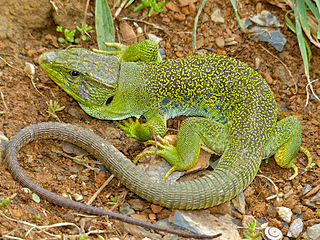
The ocellated lizard or jewelled lizard is a species of lizard in the family Lacertidae. The species is endemic to southwestern Europe.

The Madeiran wall lizard is a species of lizard in the family Lacertidae. It is the only species in the genus Teira. The species is endemic to the Madeira Archipelago, Portugal. In the Azores, this lizard has become naturalized after involuntary introduction by the shipping trade between the two archipelagos. There are four recognized subspecies. The species is both endemic and common, ranging from sea coasts to altitudes of 1,850 metres (6,070 ft). It is usually found in rocky places or among scrub and may climb into trees. It is also found in gardens and on walls. It feeds on vegetable matter and small invertebrates such as ants. The tail is easily shed and the stump regenerates slowly. The colouring is variable and tends to match the surroundings, typically a shade of brown or grey with occasionally a greenish tinge. Most animals are finely flecked with darker markings. The underparts are white or cream, sometimes with dark spots, with some males having orange or red underparts and blue throats, but these bright colours may fade if the animal is disturbed. The Madeiran wall lizard grows to a snout-to-vent length of about 8 cm (3.1 in) with a tail about 1.7 times the length of its body. Females lay two to three clutches of eggs in a year with the juveniles being about 3 cm (1.2 in) when they hatch.

Chalcides bedriagai, commonly known as Bedriaga's skink, is a species of lizard in the family Scincidae. The species is endemic to the Iberian Peninsula. It usually lives in sandy areas with sparse vegetation and good ground cover. It can also live in open woodland and burrow into loose soil. Females of the species give birth to live young. This skink is active during day and dusk, and it is very timid. It may reach about 16 cm (6.3 in) in total length, and it has five digits on each foot. It preys on insects, spiders, slugs, and woodlice.
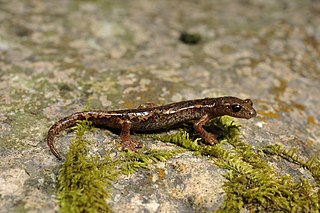
Ambrosi's cave salamander or the Spezia cave salamander is a species of salamander in the family Plethodontidae. Endemic to northwestern Italy, its natural habitats are temperate forests, rocky areas, caves, and subterranean habitats. It is threatened by habitat loss.

Kurixalus idiootocus is a small species of frog in the family Rhacophoridae. It is endemic to Taiwan and is commonly known as the temple tree frog. Its natural habitats are subtropical or tropical moist shrubland, seasonally wet or flooded lowland grassland, freshwater marshes, intermittent freshwater marshes and irrigated land. It is listed as being of "Least Concern" by the IUCN although there may be some destruction of its habitat.

The Madagascar buzzard is a bird of prey which is endemic to Madagascar. It is a species from the widespread genus Buteo in the family Accipitridae.
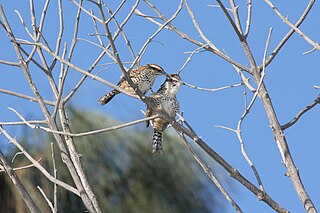
The spotted wren is a species of bird in the family Troglodytidae. It is endemic to Mexico.

The East Canary gecko or Canary wall gecko is a species of lizard in the family Phyllodactylidae. It is endemic to the eastern Canary Islands. Its natural habitats are temperate shrubland, Mediterranean-type shrubby vegetation, rocky areas, rocky shores, sandy shores, intertidal marshes, arable land, pastureland, plantations, rural gardens, and urban areas.
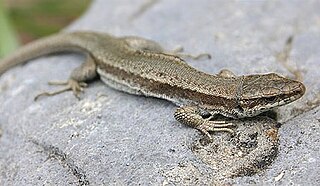
The Pyrenean rock lizard is a species of lizard in the family Lacertidae. The species is endemic to the Pyrenees, where it occurs at high altitudes and is only active in summer.

The Anatolian rock lizard is a species of lizard in the family Lacertidae. It is found in western Anatolia and on islands off the coast, where its natural habitats are temperate forests and rocky areas. A common species, the IUCN has listed it as being of "least concern".

The Mosor rock lizard is a species of lizard in the family Lacertidae. It is found in southern Croatia, Bosnia and Herzegovina, and Montenegro. Its possible presence in Albania requires confirmation. It is named after its type locality, Mount Mosor.

The sharp-snouted rock lizard is a species of lizard in the family Lacertidae. It is found in Bosnia and Herzegovina, Croatia, Montenegro, and possibly Albania, where its natural habitats are Mediterranean-type shrubby vegetation, rocky areas, rocky shores, rural gardens, and urban areas.

Bocage's wall lizard is a species of lizard in the family Lacertidae. The species is endemic to the Iberian Peninsula. Its natural habitats are temperate forests, temperate shrubland, Mediterranean-type shrubby vegetation, sandy shores, rural gardens, and urban areas. The IUCN does not consider it to be threatened.
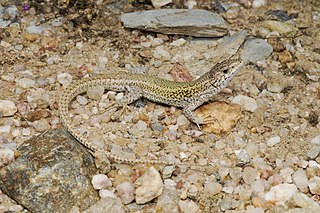
Podarcis carbonelli, commonly known as Carbonell's wall lizard, is a species of lizard in the family Lacertidae. The species is native to Portugal and Spain.

The filfola lizard or Maltese wall lizard is a species of lizard in the family Lacertidae. It is found in Italy and in the island group of Malta. Its natural habitats are Mediterranean-type shrubby vegetation, rocky areas, rocky shores, arable land, pastureland, and rural gardens.

Lilford's wall lizard is a species of lizard in the family Lacertidae. The species is endemic to the Gymnesian Islands, the easternmost of the Balearic Islands, Spain.

The Peloponnese wall lizard is a species of lizard in the family Lacertidae. It is endemic to the Peloponnese region of southern Greece. Its natural habitats are Mediterranean-type shrubby vegetation, rocky areas, arable land, pastureland, plantations, and rural gardens.

The Ibiza wall lizard is a species of lizard in the family Lacertidae. It is most closely associated with the island of Eivissa, or Ibiza, in the Balearic Islands, but has become naturalized in parts of Spain.

The Balkan whip snake is a species of snake in the family Colubridae. It is found in Italy, Greece and most of the Balkan countries where its natural habitats are Mediterranean-type shrubby vegetation, pastureland, plantations and rural gardens. It is threatened by habitat loss in parts of its range but overall is assessed by the IUCN as being of "least concern".

Elaphe quatuorlineata is a member of the family Colubridae. The four-lined snake is a non-venomous species and one of the largest of the European snakes.





















